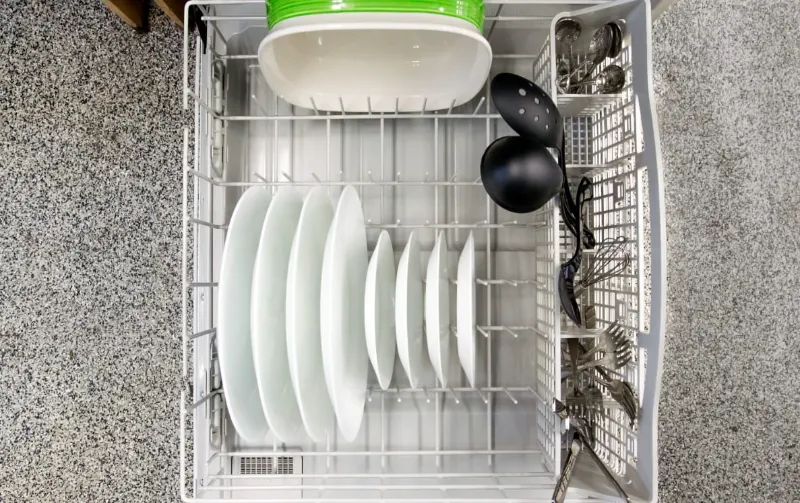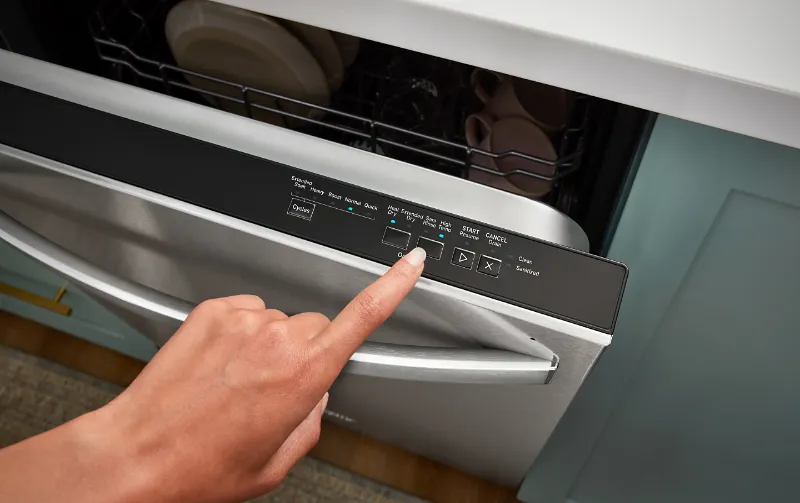A regular cycle of a Whirlpool dishwasher typically takes around 2-3 hours to complete. The exact duration may vary based on the model and settings used.
A Whirlpool dishwasher is a convenient appliance for efficient and thorough dish cleaning.
With a variety of cycle options available, it’s important to understand the approximate time required for each cycle.
By knowing how long a cycle typically takes, users can plan their dishwashing activities accordingly.
Whether it’s a quick wash for lightly soiled items or a heavy-duty cycle for tough, baked-on residue, the Whirlpool dishwasher offers flexibility to meet various cleaning needs.
Understanding the time commitment for each cycle allows for better time management and ensures clean dishes when needed.

Determining The Default Cycle Time
When investing in a new dishwasher, one of the top considerations is its cycle duration.
The default cycle time of a Whirlpool dishwasher is an important aspect to understand for efficient planning of your household chores.
Knowing the duration of the default cycle can help you manage your time effectively and ensure that your dishes are cleaned according to your schedule.
Normal Cycle Duration
The normal cycle duration of a Whirlpool dishwasher typically ranges from 2 to 3 hours.
This duration may vary slightly depending on the specific model and additional settings applied.
The normal cycle is designed to effectively clean a full load of dishes, pots, and pans, ensuring sparkling results without compromising on cleanliness or efficiency.
Factors Affecting Cycle Length
Several factors can influence the length of a dishwasher cycle, including:
- The dishwasher’s sensor may adjust the cycle length based on the level of grime and food particles on the dishes.
- A higher water temperature can lead to shorter cycle times as it aids in more efficient cleaning and drying processes.
- Choosing energy-saving settings may extend the cycle duration to conserve energy and water.
- Some cycles include extended drying phases, which may lengthen the overall cycle time.
Comparison With Other Cycles
When comparing the default cycle time of a Whirlpool dishwasher with other available cycles, such as the quick or express cycles, it’s important to note that these shorter cycles may sacrifice some cleaning performance for speed.
The difference in cycle duration between the normal cycle and the quick cycle can be substantial, with the quick cycle taking around 30 minutes or less.
However, it is designed for lightly soiled dishes and may not provide the same level of deep cleaning as the standard cycle.
Loading The Dishwasher Effectively
Whirlpool dishwashers typically take around 2-3 hours to complete a full wash cycle, with varying times depending on the selected cycle and soil level.
Loading the dishwasher effectively can help optimize the cleaning process and ensure efficient operation, ultimately leading to sparkling clean dishes in a timely manner.
Organizing Dishes For Maximum Efficiency
When it comes to loading your Whirlpool dishwasher effectively, it’s essential to organize your dishes for maximum efficiency.
By strategically arranging your items, you can ensure a thorough and consistent cleaning for every load.
Consider following these tips for optimal organization:
- Be sure to scrape off excess food particles before loading the dishes for maximum efficiency and to prevent clogging in the dishwasher drain.
- Place utensils with handles facing downward to avoid impeding the water flow and ensure proper cleaning.
- Alternate larger and smaller plates to prevent them from nesting together and obstructing the water and detergent flow.
- Angle bowls slightly to allow water to reach their interiors effectively, resulting in a thorough clean.
Utilizing Dishwasher Racks Effectively
Effectively utilizing the dishwasher racks will contribute to the overall cleanliness and efficiency of your dishwashing cycle.
To ensure each rack is utilized to its full potential:
- Place glasses, cups, and smaller items facing down to allow for proper water drainage and even cleaning.
- Utilize the tines to securely hold plates and pans, avoiding crowding to allow for unobstructed water flow.
- Differentiate utensils to prevent them from clumping together, ensuring that water can reach each piece for thorough cleaning.
Preparing Dishes For Quick Wash
If you’re looking to save time with your Whirlpool dishwasher, the quick wash cycle can be a lifesaver.
But before you start the cycle, it’s important to prepare your dishes properly to ensure they come out sparkling clean.
Here are some tips for getting the most out of your quick wash cycle.
Scraping And Pre-rinsing
Before loading your dishes into the dishwasher, make sure to scrape off any large food particles into the trash can.
However, it’s not necessary to pre-rinse the dishes thoroughly, as modern dishwashers are designed to handle dishes with some food residue.
Simply remove excess food and leave the rest in the dishwasher.
Selecting The Appropriate Wash Cycle
When using the quick wash cycle, it’s important to select the appropriate cycle for the level of soiling on your dishes.
Most Whirlpool dishwashers offer a variety of wash cycles, including a quick wash option specifically designed for lightly soiled dishes.
Make sure to choose this option to ensure an efficient and thorough cleaning process within a shorter timeframe.
The Express Wash Option
When you’re pressed for time but still need sparkling clean dishes, the express wash cycle on your Whirlpool dishwasher is a game-changer.
This convenient feature is designed to deliver outstanding cleaning performance in a fraction of the time it takes for a regular cycle.
Let’s delve into the benefits of the express wash cycle and learn about the ideal dish load for this time-saving option.
Benefits Of The Express Wash Cycle
The express wash cycle is perfect for quickly tackling lightly soiled dishes, allowing you to have them ready for your next meal or event without a long wait.
It typically completes a cycle in approximately 1 hour or less, making it ideal for busy households or entertaining occasions.
Whether you need to refresh glassware, dessert plates, or utensils, the express wash option efficiently handles the job while conserving water and energy.
Suitable Dish Load For Express Wash
When utilizing the express wash cycle, it’s essential to load dishes strategically to ensure thorough cleaning within the shortened timeframe.
The recommended dish load may include saucers, cups, and serving utensils.
Avoid overcrowding or stacking items, as this can impede water and detergent distribution, resulting in subpar cleaning performance.
By arranging dishes strategically and keeping them well-spaced, the express wash cycle can effectively handle a moderate load of lightly soiled items, leaving them spotless and ready for use.

Rapid Wash For Time Savings
The Ideal Dish Load For Rapid Wash
When using rapid wash on a Whirlpool dishwasher, it’s important to optimize the dish load for maximum efficiency.
The ideal dish load for rapid wash is a moderately soiled load of dishes, suitable for a quick yet effective cleaning cycle.
Avoid overloading the dishwasher, as this may hinder the cleaning process.
Comparing Rapid Wash With The Normal Cycle
Understanding the differences between rapid wash and the normal cycle can help in making an informed decision.
Rapid wash is designed for lightly soiled dishes and offers a faster cleaning time, typically around 1 hour.
On the other hand, the normal cycle is suitable for heavily soiled dishes and may take longer, usually around 2-3 hours.
Consider the level of soiling on your dishes to determine which cycle best suits your needs.
Regular Cleaning And Maintenance
Regular cleaning and maintenance of your Whirlpool dishwasher is essential to ensure its optimal performance and longevity.
By keeping your dishwasher in top condition, you can prevent potential issues and maintain efficient operation.
Here’s a look at the importance of cleanliness and how you can prevent clogs and buildup to ensure your Whirlpool dishwasher’s functionality.
Importance Of Cleanliness
Cleaning your dishwasher regularly is crucial for maintaining a hygienic environment for your dishes and utensils.
Over time, food particles, grease, and soap residue can accumulate, leading to unpleasant odors and potentially affecting the cleaning performance.
Regular cleaning not only ensures that your dishes come out sparkling clean but also helps to extend the lifespan of your dishwasher.
Preventing Clogs And Buildup
Preventing clogs and buildup in your Whirlpool dishwasher is vital to avoid costly repairs and maintain efficient operation.
Regularly check and clean the filter, spray arms, and door gasket to prevent the accumulation of debris and mineral deposits.
Using a dishwasher cleaner as recommended by the manufacturer can help remove any lingering residue and maintain optimal water flow throughout the machine.
Troubleshooting Time-related Issues
When using a Whirlpool dishwasher, it’s essential to consider the time it takes to complete a cycle.
If you notice any significant time delays or issues with the duration of the cycle, it’s crucial to address and resolve these problems promptly.
Addressing Potential Time Delays
If you observe that your Whirlpool dishwasher is taking longer than usual to complete a cycle, there are several potential causes to consider.
Take the following steps to address potential time delays:
- Ensure that the dishwasher has proper water pressure and that the water inlet valve is not clogged.
- A malfunctioning heating element can lead to extended cycle times. Verify that the heating element is functioning correctly.
- Clogged filters can impede water flow, resulting in prolonged cycle durations. Regularly clean the filters to prevent this issue.
- Overloading the dishwasher or arranging dishes in a manner that obstructs the water spray can contribute to longer cycle times. Arrange dishes strategically to ensure proper water circulation.
Seeking Professional Assistance If Necessary
If you have attempted the troubleshooting steps mentioned above and are still experiencing prolonged cycle times with your Whirlpool dishwasher, it may be necessary to seek professional assistance.
A certified technician can diagnose the underlying issue and perform repairs to restore the dishwasher’s optimal performance.
Frequently Asked Questions For How Long Does Whirlpool Dishwasher Take
How Long Does A Typical Wash Cycle Take?
A typical wash cycle in a Whirlpool dishwasher takes around 2-3 hours to complete.
What Factors Affect The Duration Of The Wash Cycle?
The duration of the wash cycle can be influenced by several factors such as the soil level of the dishes, the water temperature, and the selected wash cycle.
Is There A Way To Shorten The Wash Cycle Time?
Yes, using the “1-Hour Wash” or “Express” cycle option on certain Whirlpool dishwasher models can significantly reduce the duration of the wash cycle, providing a quicker cleaning solution for lightly soiled dishes without sacrificing performance.
How Does The Dishwasher’s Energy Efficiency Relate To Cycle Duration?
Whirlpool dishwashers are designed with energy-efficient features that optimize performance while minimizing energy consumption.
Conclusion
Knowing the exact time a Whirlpool dishwasher takes is crucial for efficient planning.
By understanding the factors that affect cycle duration, such as the chosen settings and model type, you can make the most of your appliance.
With this knowledge, you can enjoy sparkling, clean dishes without any unnecessary delays.

